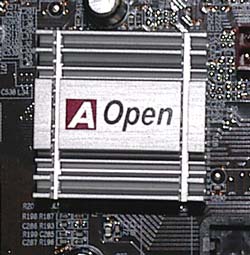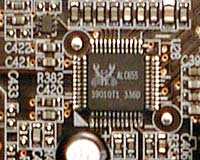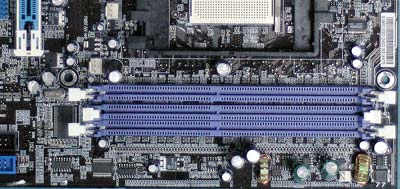AOpen AK86-L UPDATE: Uncommonly Good
by Wesley Fink on March 30, 2004 1:00 PM EST- Posted in
- Motherboards
AOpen AK86-L: Basic Features
| Motherboard Specifications | |
| CPU Interface | Socket 754 Athlon64 |
| Chipset | VIA K8T800/VIA VT8237 |
| Bus Speeds | 200MHz to 255MHz (in 1MHz increments) |
| PCI/AGP Speeds | None. BIOS reports AGP/PCI frequencies as FSB changes |
| Available CPU Ratios | CPU ratios below rated multiplier can be selected in the range of 4x - 16x |
| Core Voltage | Normal, 0.8V to 1.55 V in .025V increments |
| DRAM Voltage | Normal, 2.50V to 2.70V in 0.05V increments |
| AGP Voltage | 1.5V, 1.533V, 1.566V, 1.6V |
| Memory Slots | Three 184-pin DDR DIMM Slots Single-Channel Configuration Regular Unbuffered Memory to 2GB Total |
| Expansion Slots | 1 AGP 8X Slot 5 PCI Slots |
| Onboard Serial ATA RAID | VIA 8237 (2 Drives, 0, 1) |
| Onboard IDE | Two Standard VIA ATA133/100/66 (4 drives) |
| Onboard USB 2.0/IEEE-1394 | 8 USB 2.0 ports supported by 8237 No FireWire ports |
| Onboard LAN | Realtek RTL8110S Gigabit LAN |
| Onboard Audio | Realtek ALC655 codec AC '97 2.3 6-Channel with UAJ |
| BIOS Revision | 1.06M (2/03/2004) |

The packaging is a rather basic green on white, but the feature list is very extensive. For a motherboard selling at a bit less than $100, you get the full range of AOpen features, including SilentTek smart fan controller to lower system noise, EZWin Flash for BIOS updates from Windows, Watch Dog for recovering from bad overclocks, and the EzClock utility for overclocking while in Windows. AOpen includes the VIA RAID driver floppy that is needed for installing the OS with a SATA drive. Many manufacturers have started leaving this necessity out of the box - forcing the installer to find another PC to create the install floppy.

The AK86-L back panel options include 4 USB 2.0 ports, 3 individual mini jacks for audio, Gigabit LAN, PS2 mouse/keyboard ports, Parallel, and a single serial port. There are additional headers on the motherboard for a 2nd serial port and a game port, but brackets for the game and the 2nd serial are not included in the retail package.

The VIA K8T800 is a traditional Northbridge/Southbridge chipset. A large passive heatsink is used on the Northbridge instead of an active solution used in other designs. However, we did not have any overheating problems in our benchmarking. The 8237 Southbridge has much less to do with the memory controller on the Athlon 64 chip, and does not provide any cooling. The Southbridge also remained cool during benchmarking.

AOpen has included provisions for 2 SATA drives supported by the 8237, either regular SATA or SATA RAID 0 or 1.

The AOpen AK86-L uses the Realtek audio codec called ALC655, which is compliant with the latest AC '97 Rev. 2.3. This audio codec features 6-channel sound and UAJ or Universal Audio Jack, with a better than 90db signal-to-noise ratio. This allows automatic jack programming as we've seen on some boards based on Intel's 865/875 chipsets. The ALC655 is quite similar to the Realtek premium ALC658 sound solution. Additional information and specifications are available at Realtek.
While an SPDIF bracket is not included in the AK86-L package, there is an SPDIF I/O header on the motherboard. In addition, there is an audio connection header with connector options and two connectors for Optical Drive audio cables. While the audio input and output options are very good, please keep in mind that you must find and put in additional brackets to use many of the audio options. The brackets are not part of the standard package.

One of the first things that many manufacturers seem to eliminate when they build a $100 board is fan-headers. AOpen has a really effective smart fan control system and they also thoughtfully included five fan headers on the board - four 3-pin headers and one 2-pin temp header. Obviously, it occurred to someone in AOpen engineering that SilentTek was only useful if there were plenty of fan headers on the board. The large number of fan headers will be appreciated by anyone with multiple cooling fans.

The AK86-L includes Realtek Gigabit LAN. LAN connections have moved from added cards to an on-board feature, and we now are starting to see Gigabit LAN become more common, even on boards designed for the mid-to-low price range. Dual color LEDs in the LAN socket indicate 10/100 or Gigabit operation.

Three DIMM slots support standard unbuffered Single-Channel memory. AOpen claims support for up to 2GB of DDR400 memory in 2 DIMMs, and up to 3GB of DDR333 or slower memory in 3 DIMMs.










22 Comments
View All Comments
howminn - Thursday, May 20, 2004 - link
I've got that board and am having hell with it. No matter what agp card, no matter what memory and in which memory slot, the board won't switch the monitor back on after restart. Which means it is not possible to install an OS onto it.I've returned the original board and bought another one, both boards have displayed the same trouble, and have both displayed cmos checksum error, default values loaded. Batteries have been changed, still no solution.
The vendor to whom I RMA'd the board have not given me any feedback as to what is wrong.
Has anybody else seen this before? Please!
cowdog - Sunday, April 4, 2004 - link
Good to see the update with information that AOpen "opened" up the bios options! Good job AOpen!Ditto what #14 said about the AK89 Max. Come on AOpen, don't overlook your nForce3 150 board!! DDR to 3.0v, cpu to 1.8v, fsb to 300Mhz. That would make my day, esp if AOpen also put that hyper-active watchdog on a shorter leash.
Ronnie - Wednesday, March 31, 2004 - link
Hey TrogdorJW, I also have the MSI K8T Neo and found that OCZ pc3200 works great for my setup, I tried some kingston hyperx pc-4000 with no luck.elixia - Wednesday, March 31, 2004 - link
Hey AMD4ME2, I had that problem on an old FIC motherboard. I simply pinned the power cable to the power supply and plugged it in. It will not hang in front of the CPU and block airflow this wayResh - Wednesday, March 31, 2004 - link
There was mention of a new board revision (as opposed to BIOS version). Could AT post the number codes for the new and old rev. to help us in purchasing?Thanks!
AMD4ME2 - Tuesday, March 30, 2004 - link
I'm a bit confused by the wording of the location of the ATX power connectors. they look to me like they are behind the processor blocking air flow, at least in my case they would be.Chuckles - Tuesday, March 30, 2004 - link
There is an error on page one (Index)."Adjustments for memory voltage have now been extended from 2.5V to 3.0v in 0.5v increments. This is an extremely wide and useful range for users trying to get the most from their memory."
Should be 0.05V instead of 0.5.
Pumpkinierre - Tuesday, March 30, 2004 - link
I posted my question on Feb.16(#12) and got my answer on March 30th (#13). Its never too late. Thanks for the follow-up.Venomous - Tuesday, March 30, 2004 - link
Westley, re: the AK89MAX.. Have them do the same kind of BIOS mods they did on the AK86. If they can bring those voltages up to AK86 specs, im sure hitting 280 fsb wont be hard. The watchdog thing IS annoying.Wesley Fink - Tuesday, March 30, 2004 - link
Pumkinierre -1.06Q was never a BIOS published by AOpen, so 1.08c is the first published BIOS that has multipliers. Ratios are the same as 1.06q, which is whole numbers - no option of 0.5 multipliers.
As I discussed in the PCI lock article and comments, the AK86-L seems to float the PCI/AGP up to 233, then at 234 it drops back to 33.3. This is a ratio arrangement very similar to what we saw in the Abit K8T800 motherboard we reviewed, and is much less flexible than a true adjustable PCI/AGP lock. If you look at the new screen captures you will see PCI/AGP now reports the rising frequency in the BIOS.
As mentioned in the update, the nForce3-150 based Gigabyte K8NNXP and the Shuttle AN50R, both nF3-150 based, are the only 2 Athlon 64 boards that I am aware of that are reported by respected writers to have AGP/PCI lock. I have not tested either with the PCI Geiger, so I can not personally confirm this. If you want fine adjustments for OC, then either of these would appear to be a better choice, at a higher price.
The AOpen AK89 Max, which is a very late nF3-150 board, also appears to have a working PCI/AGP lock, but there are some issues with high settings prematurely invoking the watchdog feature and resetting the frequency - requiring a CMOS clear. We have asked AOpen for help in resolving this issue with the AK89 Max, and if it is fixed we will post a review on Anandtech.